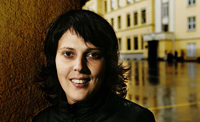Interview with Norwegian director Margreth Olin for CINEUROPA
 21/12/2012 - In her documentary Nowhere Home (De andre), Norwegian director Margreth Olin tackles a current theme that is controversial in Norway and other European countries: the status of refugees.
21/12/2012 - In her documentary Nowhere Home (De andre), Norwegian director Margreth Olin tackles a current theme that is controversial in Norway and other European countries: the status of refugees.
by Maud Forsgren
 21/12/2012 - In her documentary Nowhere Home (De andre), Norwegian director Margreth Olin tackles a current theme that is controversial in Norway and other European countries: the status of refugees.
21/12/2012 - In her documentary Nowhere Home (De andre), Norwegian director Margreth Olin tackles a current theme that is controversial in Norway and other European countries: the status of refugees.
How did you choose the young people that we see in your films?
Margreth Olin: I never sought to distribute roles. I met Hassan and his brother Husein from Afghanistan, as well as Khalid, in Salhus, a reception centre for refugees where teenagers aged 15 to 18 had been gathered to be prepared to return once they reached adulthood. Life in these centres is motionless, nothing happens. This is why I'm against a temporary residence permit for youth. They can't develop normally in such conditions, on the margins of society. I met Goli from Kurdistan shortly before his expulsion from Norway, when he came out of the Ila prison where he was being held for assault and battery. (The same prison where Anders Breivik is being held at the moment).
Margreth Olin: I never sought to distribute roles. I met Hassan and his brother Husein from Afghanistan, as well as Khalid, in Salhus, a reception centre for refugees where teenagers aged 15 to 18 had been gathered to be prepared to return once they reached adulthood. Life in these centres is motionless, nothing happens. This is why I'm against a temporary residence permit for youth. They can't develop normally in such conditions, on the margins of society. I met Goli from Kurdistan shortly before his expulsion from Norway, when he came out of the Ila prison where he was being held for assault and battery. (The same prison where Anders Breivik is being held at the moment).
Are there lots of children in this situation in Norway?Since 2009, 149 children have obtained this temporary permit. When they see the fateful date of their 18th birthday approaching, some of them choose to disappear. They lead an underground life, in which they are exposed to all sorts of dangers and temptations. It's a problem that we should really solve, as it's not only a question of these youth's protection and safety, but also ours.
Did you film a lot?An enormous amount. I had to make delicate choices during editing. But for each of the children, I tried to keep a balance, to show different aspects, not necessarily nice ones. I wanted the viewers to identify with me, the narrator, with my feelings, my emotions. But at the same time, I did not want to force the viewers to think like me.
You evoke a dream at the beginning of your film.Yes. I was wondering how to best evoke the violence inflicted on young beings. The Second World War seems far away for most Norwegians. They don't know what it means to suffer. And then the July 22, 2011 tragedy happened, with the massacre we all know about. It was a real trauma for all Norwegians. And on television I saw the eyes, the expressions, of the survivors, the same expressions as those of the young refugees, but with the enormous difference that an important support system was immediately set up for the young Norwegians. Everybody spoke of love, of solidarity... A short while afterwards, I had a striking dream, no doubt in part inspired by the Utøya tragedy. In my dream, I saw youth swimming desperately towards the riverbank, youth who were being saved, all except one young girl everybody refused to save. Discrimination. I find this difference in treatment of Norwegian and non-Norwegian children very hard to accept. Norway did ratify the International Convention on the Rights of the Child on January 8, 1991. I then decided that this dream sequence would open my film, and this is why the film is called De andre (lit. "the others").









No comments:
Post a Comment